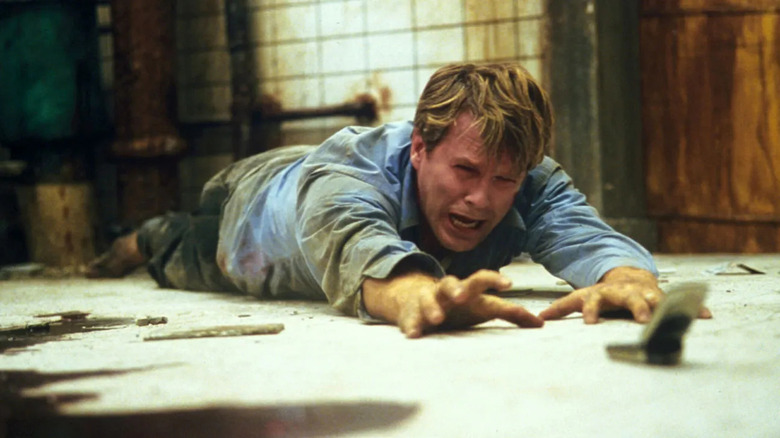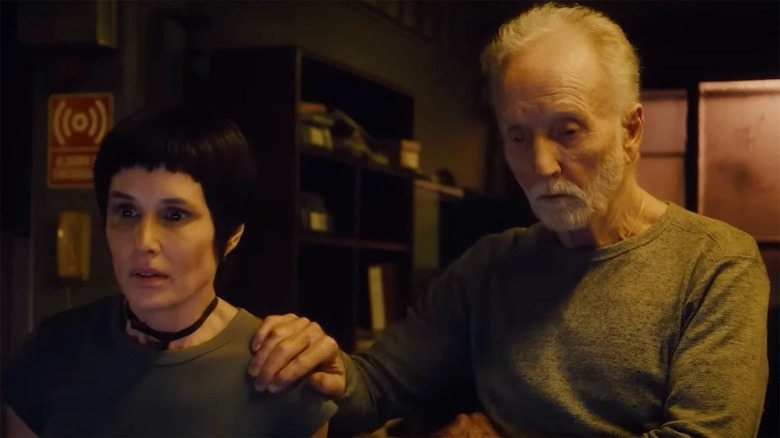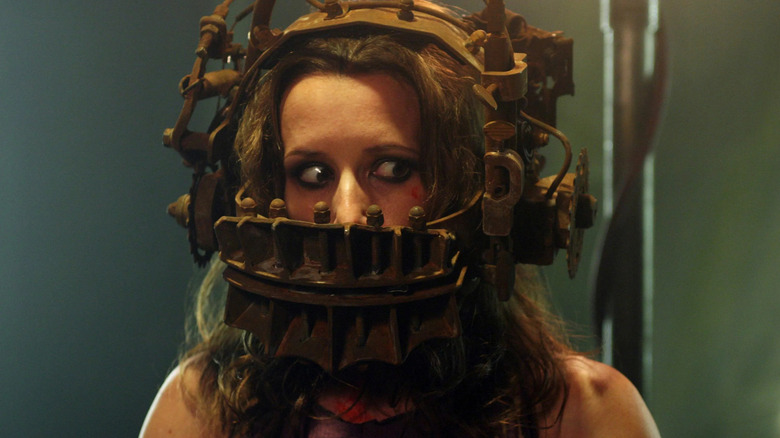The Correct Order To Watch The Saw Franchise
What began as a simple two-hander about strangers chained in a squalid bathroom, enduring the twisted games of a mysterious tormentor, has evolved into an intricate saga spanning nearly twenty years and ten gruesome films. With every new "Saw" movie, the traps become bigger and more brutal, the timelines increasingly jumbled, and the twists even more mind-boggling. Each "Saw" entry delves deeper into (and complicates) the maniacal Jigsaw philosophy that forces people to confront their sins and appreciate the life they've been given.
Often regarded as part of the controversial horror subgenre "torture porn" (even though we may need to retire that term forever), the "Saw" films feature graphic depictions of mutilation and extreme violence in elaborate devices that are not for the faint of heart. While it can be daunting to tackle such a visceral and temporally complex series, there is really only one solid path to follow when watching these films that ensures the most coherent and thrilling first-time viewing experience.
Play by the rules and order by release date
"Saw" made waves after its Sundance Film Festival premiere in 2004, gaining recognition for its shocking narrative detours and grisly, "Se7en"-esque filmmaking style. After earning over $103 million at the box office (on a $1.2 million budget), sequels inevitably followed, and "Saw" quickly became a Halloween tradition for the next six years. Every sequel expands in scale and spectacle, and watching them in their original release order allows you to see that clever (and crazy) build-up of storytelling. Here is the entire "Saw" series in release order:
- "Saw" (2004)
- "Saw II" (2005)
- "Saw III" (2006)
- "Saw IV" (2007)
- "Saw V" (2008)
- "Saw VI" (2009)
- "Saw 3D" (Also known as "Saw: The Final Chapter") (2010)
- "Jigsaw" (2017)
- "Spiral: From the Book of Saw" (2021)
- "Saw X" (2023)
Touted as "The Final Chapter," the seventh installment of the "Saw" series appeared to be the end of the franchise, especially because it provides answers to some long-awaited questions. Nearly a decade later, the franchise made a not-so-triumphant return with "Jigsaw." The film has sleek visuals but a lackluster story, yet it marks a fresh phase in "Saw" storytelling that expands beyond the central character of Jigsaw to explore his enduring legacy. "Saw X" has been the most successful entry, garnering critical acclaim for maintaining its torture porn roots while infusing the narrative with an emotional gravitas that reveals the humanistic side of Tobin Bell's John Kramer character.
While all of these films go back and forth between timelines, such as "Saw X" technically taking place in the past between "Saw I" and "Saw II," watching them in release order makes everything easier to follow — even when the twists are baffling.
Piecing the series together chronologically
Do you want to play a game? Try watching the "Saw" series chronologically! There's so much temporal shuffling in these movies that it's not an easy task, but here is an attempt to place them in sequential order:
- "Jigsaw" (2017)
- "Saw" (2004)
- "Saw X" (2023)
- "Saw II" (2005)
- "Saw III" (2006)
- "Saw IV" (2007)
- "Saw V" (2008)
- "Saw VI" (2009)
- "Saw: The Final Chapter" AKA "Saw 3D" (2010)
- "Spiral: From The Book Of Saw" (2021)
Viewing the series in this way would allow you to trace Jigsaw's origins, the development of his sadistic traps, and others continuing or copying his legacy. But there are so many shifts in timelines that play an important role in the set-up of events and the final twist. For example, "Saw X" technically takes place between "Saw" and "Saw II," but if you were to watch the series for the first time in chronological order, you would not quite understand the dynamics of the relationship between John Kramer and his protegee Amanda (Shawnee Smith). The initial trilogy lays the foundation for their close bond, and "Saw X" has a greater impact on an audience with that previous knowledge.
Release order is the only way to play the game
For first-time viewers, it's best to avoid watching the "Saw" series in chronological order. That approach is better suited for seasoned viewers already familiar with the narrative twists and turns. The first three films form a perfect trilogy that provides vital context for how the rest of the series unfolds. Without them as a foundation, the chronological order leaves new viewers completely lost. You would prematurely encounter crucial plot twists, dampening the impact and suspense of these carefully orchestrated and jaw-dropping revelations. Sticking to release order allows you to view the "Saw" series as theatrical audiences did — event movies that took the Jigsaw story to new heights each time.
It's difficult enough to understand the labyrinthine storylines as it is, so viewing the series chronologically for the very first time would be like throwing a jigsaw puzzle on the ground and trying to pick up the pieces.



